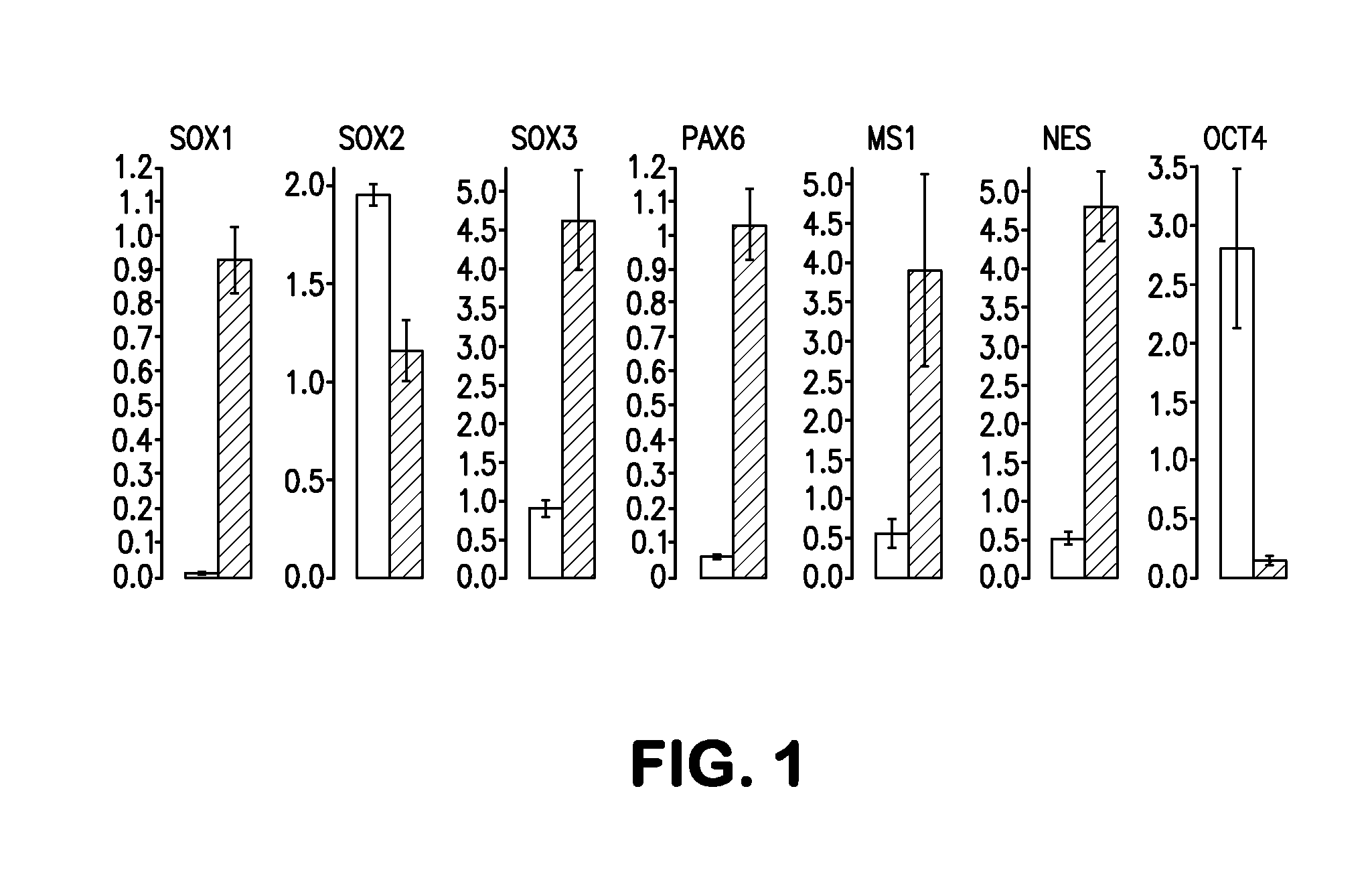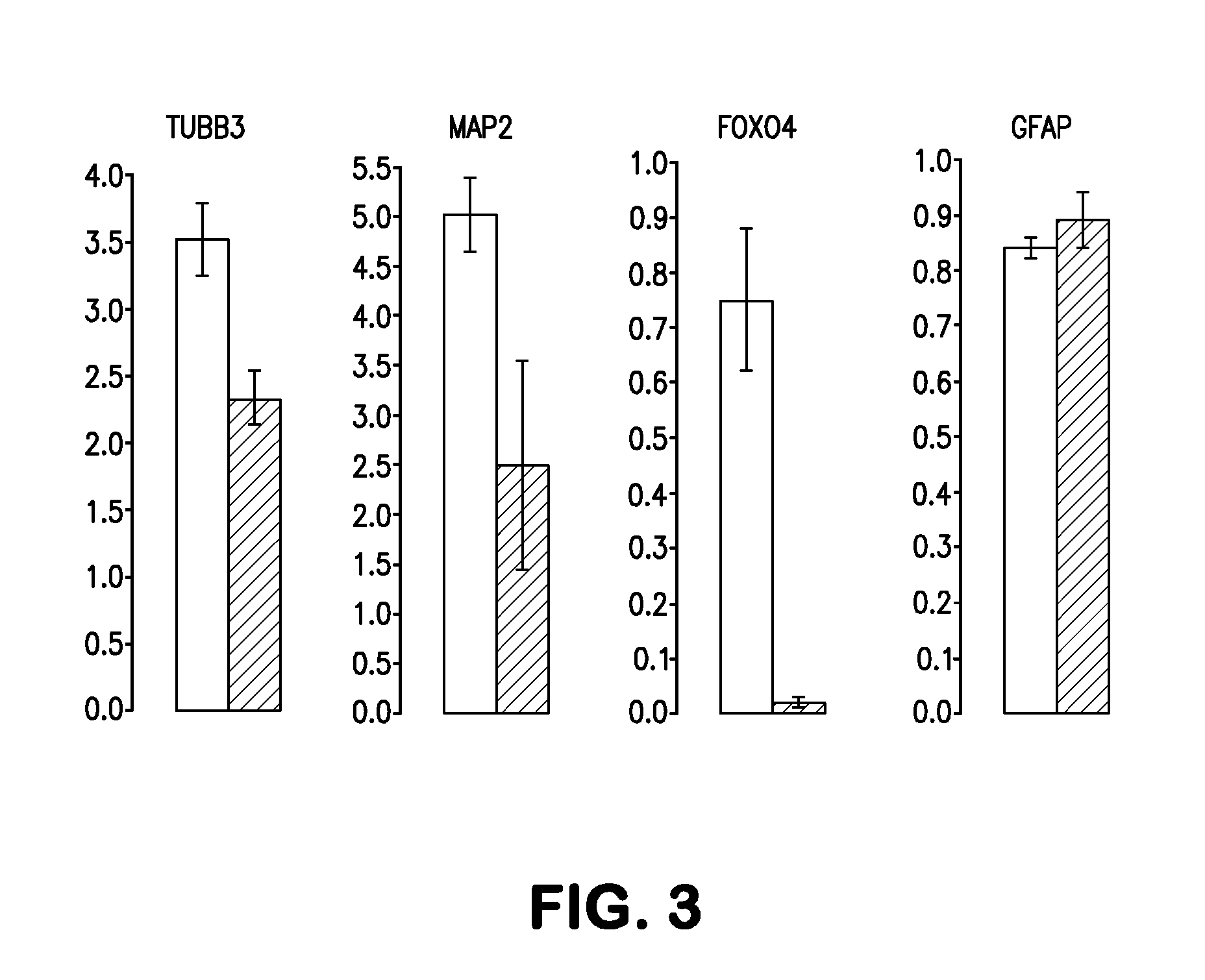Methods and compositions of producing patient-specific multipotent neuronal stem cells
a multi-potent, neuronal stem cell technology, applied in the field of stem cells, can solve the problems that the hpsc does not raise the same ethical concerns and the long-proliferating human parthenogenetic nsc has not yet been obtained
- Summary
- Abstract
- Description
- Claims
- Application Information
AI Technical Summary
Benefits of technology
Problems solved by technology
Method used
Image
Examples
example 1
Production of Human Parthenogenic Embryogenic Stem Cells
[0112]Materials and Methods
[0113]Donors voluntarily donated eggs and blood (for DNA analysis) with no financial payment. Donors signed comprehensive informed consent documents and were informed that all donated materials were to be used for research and not for reproductive purposes. Before ovarian stimulation, oocyte donors underwent medical examination for suitability according to FDA eligibility determination guidelines for donors of human cells, tissues, and cellular and tissue-based products (Food and Drug Administration. (Draft) Guidance for Industry: Eligibility Determination for Donors of Human Cells, Tissues, and Cellular and Tissue Based Products (HCT / Ps) dated May 2004) and order N 67 (Feb. 26, 2003) of Russian Public Health Ministry. It included X-ray, blood and urine analysis, and liver function test. Donors were also screened for syphilis, HIV, HBV, and HCV.
[0114]Oocytes were obtained using standard hormonal stimu...
example 2
Maintenance of Human Parthenogenetic Stem Cells
[0132]Human parthenogenetic stem cell lines, produced in a similar manner as described above, phESC-1, phESC-3 [1] and hpSC-Hhom-4 [2], were maintained on Mitomycin-C inactivated mouse embryonic fibroblasts (Millipore) feeder layer in ES-medium: KDMEM / F12 (Invitrogen), supplemented with 15% KSR (Invitrogen Grand Island, N.Y.), 2 mM L-glutamine (GlutaMAX-I, Invitrogen Grand Island, N.Y.), 0.1 mM MEM nonessential amino acids (Invitrogen), 0.1 mM β-mercaptoethanol (Invitrogen Grand Island, N.Y.), penicillin / streptomycin / amphotericin B (100 U / 100 μg / 250 ng) (MP Biomedicals) and 5 ng / ml bFGF (Peprotech). Cells were passaged with Dispase or Collagenase IV (both Invitrogen Grand Island, N.Y.) every 5-7 days with split ratio of 1:4 or 1:6. There were no obvious differences in experimental results from the hpSC lines used in our study, so the data were pooled.
[0133]Good results in obtaining of Neuroepithelial Rosettes can be achieved with mainta...
example 3
Materials and Methods for Culture Media Preparation and Petri Dish Coating
[0134]Materials
Knockout DMEM / F12, Invitrogen, 12660-012
[0135]DMEM / F12, Invitrogen, 10565-018, (supplemented with GlutaMAX™-I Supplement as a source of L-Glutamine).
GlutaMAX™-I Supplement, Invitrogen, 35050-061
MEM Non-Essential Amino Acids Solution 10 mM (100×), Invitrogen, 11140-050
CELLstart™, Invitrogen, A10142-01
StemPro® Accutase® Cell Dissociation Reagent, Invitrogen, A11105-01
StemPro Neural Supplement, Invitrogen, A10508-01
N2 Supplement (100×), Invitrogen, 17502-048
[0136]Dulbecco's Phosphate-Buffered Saline (D-PBS) (1×), Invitrogen, 14040-133, (with Ca2+ and Mg2+)
EGF Recombinant Human, Invitrogen, PHG0314
Recombinant Human FGF-basic, Peprotech, 100-18B
Penicillin-Streptomycin-Amphotericin Solution (100×), VWR, 1674049
Dulbecco's Phosphate-Buffered Saline (D-PBS) (1×), w / o Ca2+, Mg2+, VWR, 16777-150
[0137]Medium for Neural Induction
[0138]The title and composition of the medium are described in Shin et al. [11]....
PUM
 Login to View More
Login to View More Abstract
Description
Claims
Application Information
 Login to View More
Login to View More - R&D
- Intellectual Property
- Life Sciences
- Materials
- Tech Scout
- Unparalleled Data Quality
- Higher Quality Content
- 60% Fewer Hallucinations
Browse by: Latest US Patents, China's latest patents, Technical Efficacy Thesaurus, Application Domain, Technology Topic, Popular Technical Reports.
© 2025 PatSnap. All rights reserved.Legal|Privacy policy|Modern Slavery Act Transparency Statement|Sitemap|About US| Contact US: help@patsnap.com



